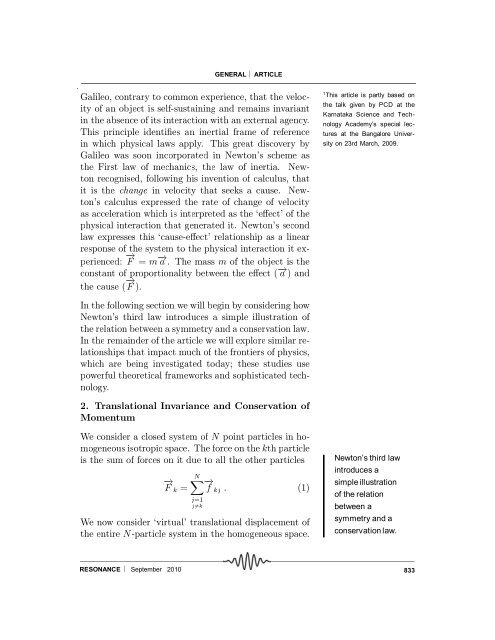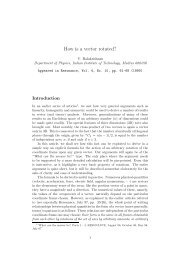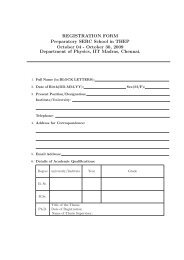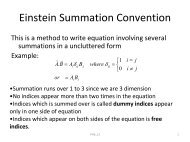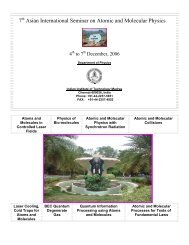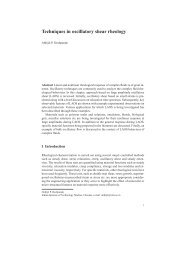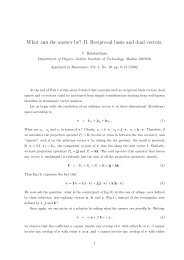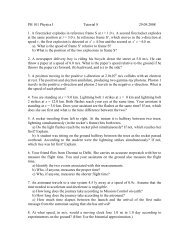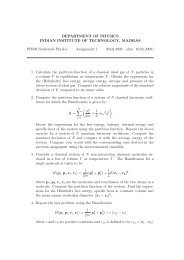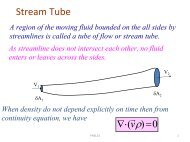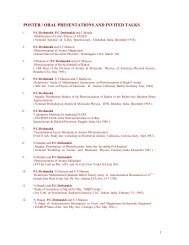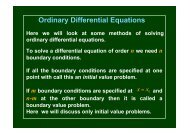Symmetry Principles and Conservation Laws in Atomic and ...
Symmetry Principles and Conservation Laws in Atomic and ...
Symmetry Principles and Conservation Laws in Atomic and ...
Create successful ePaper yourself
Turn your PDF publications into a flip-book with our unique Google optimized e-Paper software.
GENERAL ARTICLEGalileo, contrary to common experience, that the velocityof an object is self-susta<strong>in</strong><strong>in</strong>g <strong>and</strong> rema<strong>in</strong>s <strong>in</strong>variant<strong>in</strong> the absence of its <strong>in</strong>teraction with an external agency.This pr<strong>in</strong>ciple identi¯es an <strong>in</strong>ertial frame of reference<strong>in</strong> which physical laws apply. This great discovery byGalileo was soon <strong>in</strong>corporated <strong>in</strong> Newton's scheme asthe First law of mechanics, the law of <strong>in</strong>ertia. Newtonrecognised, follow<strong>in</strong>g his <strong>in</strong>vention of calculus, thatit is the change <strong>in</strong> velocity that seeks a cause. Newton'scalculus expressed the rate of change of velocityas acceleration which is <strong>in</strong>terpreted as the `e®ect' of thephysical <strong>in</strong>teraction that generated it. Newton's secondlaw expresses this `cause-e®ect' relationship as a l<strong>in</strong>earresponse of the system to the physical <strong>in</strong>teraction it experienced:¡! F = m ¡! a . The mass m of the object is theconstant of proportionality between the e®ect ( ¡! a ) <strong>and</strong>the cause ( ¡! F ).1 This article is partly based onthe talk given by PCD at theKarnataka Science <strong>and</strong> TechnologyAcademy’s special lecturesat the Bangalore Universityon 23rd March, 2009.In the follow<strong>in</strong>g section we will beg<strong>in</strong> by consider<strong>in</strong>g howNewton's third law <strong>in</strong>troduces a simple illustration ofthe relation between a symmetry <strong>and</strong> a conservation law.In the rema<strong>in</strong>der of the article we will explore similar relationshipsthat impact much of the frontiers of physics,which are be<strong>in</strong>g <strong>in</strong>vestigated today; these studies usepowerful theoretical frameworks <strong>and</strong> sophisticated technology.2. Translational Invariance <strong>and</strong> <strong>Conservation</strong> ofMomentumWe consider a closed system of N po<strong>in</strong>t particles <strong>in</strong> homogeneousisotropic space. The force on the kth particleis the sum of forces on it due to all the other particles¡! F k =NX ¡! f kj : (1)j=1j6=kWe now consider `virtual' translational displacement ofthe entire N-particle system <strong>in</strong> the homogeneous space.Newton’s third law<strong>in</strong>troduces asimple illustrationof the relationbetween asymmetry <strong>and</strong> aconservation law.RESONANCE September 2010833


